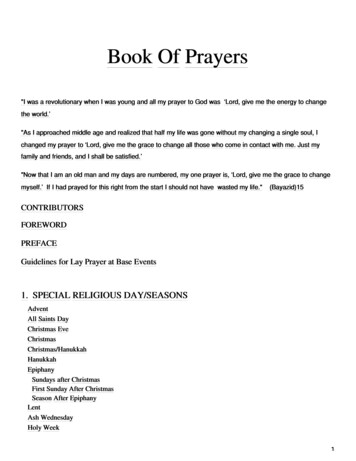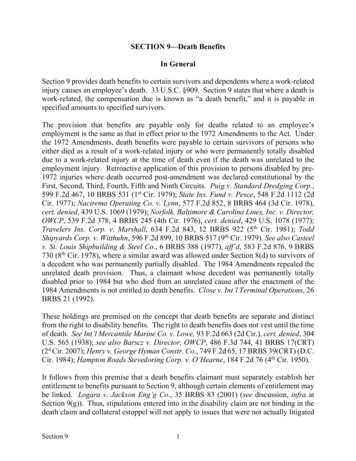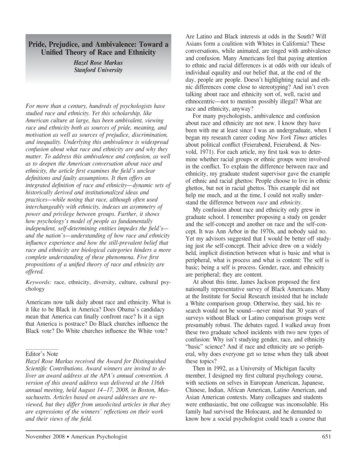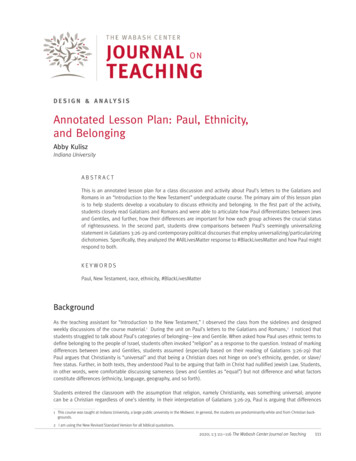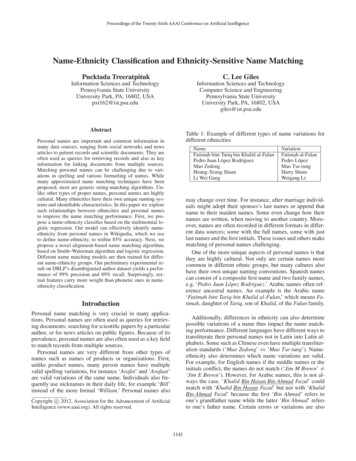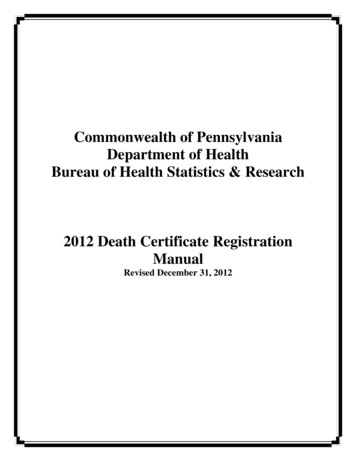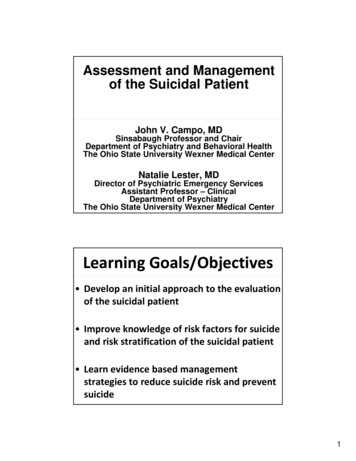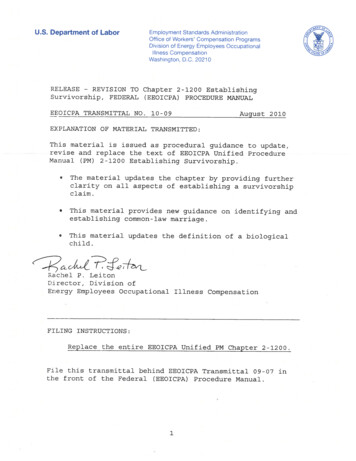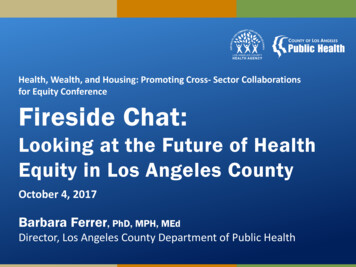
Transcription
DEATH AND ETHNICITY: A PSYCHOCULTURAL STUDY—TWENTY-FIVE YEARS LATERCynthia A. Peveto, B.S., M.A.Dissertation Prepared for the Degree ofDOCTOR OF PHILOSOPHYUNIVERSITY OF NORTH TEXASDecember 2001APPROVED:Bert Hayslip, Jr., Major ProfessorJohn Hipple, Committee MemberJudith A. McConnell, Committee MemberC. Edward Watkins, Committee MemberC. Neal Tate, Dean of the Robert B.Toulouse School of Graduate Studies
Peveto, Cynthia A., Death and ethnicity: A psychocultural study – twenty-fiveyears later. Doctor of Philosophy (Counseling Psychology), December 2001, 232 pp.,1 table, 3 appendices, references, 103 titles.This study compares ethnic, age, and gender differences concerning attitudes andbehaviors toward death, dying, and bereavement among Caucasian, African, Hispanic,and Asian American adult participants in north Texas with the results of a 1976 study byKalish and Reynolds on death attitudes and behaviors of Caucasian, African, Mexican,and Japanese American adult participants in Los Angeles, California. A modified versionof Kalish and Reynolds’ study questionnaire was administered to 526 respondents (164Caucasian, 100 African, 205 Hispanic, and 57 Asian Americans) recruited fromcommunity and church groups. Findings of this study were compared with those ofKalish and Reynolds in specific areas, including experience with death, attitudes towardone’s own death, dying, and afterlife, and attitudes toward the dying, death, or grief ofsomeone else. Data was analyzed employing the same statistical tools as those used byKalish and Reynolds, i.e., chi square calculations, frequencies, percentages, averages, andanalyses of variance. As compared with the earlier study, results indicated that thisstudy’s participants were less likely to have known as many persons who had diedrecently or to state they would try very hard to control grief emotions in public. Presentstudy participants were more likely to have visited dying persons, to want to be informedif they were dying and believe that others should be informed when dying, to prefer to dieat home, to have made arrangements to donate their bodies or body parts to medicine, to
have seriously talked with others about their future deaths, to consider theappropriateness of mourning practices and the comparative tragedy of age of death froma relative standpoint, and to want to spend the final six months of their lives showingconcern for others. Between study differences were found in ethnic group, age group,and gender group comparisons. Within study differences in death and dying attitudeswere also found in this study among ethnic, age, and gender groups.
Copyright 2001ByCynthia A. Pevetoii
ACKNOWLEDGMENTSI wish to thank Dr. Bert Hayslip, Jr., my advisor, for his generous assistance,guidance, and expertise with this study. Dr. Hayslip suggested the topic and providedhelpful advice throughout the project. I also appreciate the generosity and input of myknowledgeable committee members, Dr. John Hipple, Dr. Judy McConnell, and Dr. EdWatkins.In addition, I would like to acknowledge my appreciation to the many personswho assisted with my data collection, including: Minerva Carano, Liliana Carrillo,Marilyn Clark, Gretchen Feinshals, Isabel Gomez, Tony Han, Kamili Johnson, ShondaJones, Dong Sub Lee, Janice Moore, Juan Osorio, Margaret Watkins, and Moses Yanez.Finally, I express my deepest gratitude to my family, Rod, Drew, and Christina,for their understanding, consideration, and support through this experience.iii
TABLE OF CONTENTSPageLIST OF TABLES viChapter1. INTRODUCTION 1An Overview of Death and EthnicityThe Role of AgeGender, Education, and ReligiousnessBlack AmericansJapanese AmericansMexican AmericansCultural ChangeThis Study2. METHODOLOGY 93SubjectsMeasuresData Analysis3. RESULTS .105Comparison of Results Between the Present Study andKalish and Reynolds’ StudyComparison of Results Within the Present StudyResults Regarding Hypotheses4. DISCUSSION . 135Discussion of HypothesesDiscussion of Differences Between Kalish and Reynolds’Study and the Present StudyDiscussion of Differences Between Ethnic, Age, andGender GroupsApplications of Study ResultsLimitations of the StudyImplications for Future Researchiv
APPENDICES .170REFERENCES 244v
LIST OF TABLESTable1.PageComparison of Ethnicity, Age, Gender, and Marital Status ofSample in Kalish and Reynolds’ Study with Sample in ThisStudy 102vi
CHAPTER IINTRODUCTIONEach generation and each society has come up with its own solutions to theproblem of death and has enshrined them in a complex web of beliefs andcustoms which, at first glance, seem so diverse as to be impossible to digest. Yetthere are common themes that run through all of them (Parkes, Laungani, &Young, 1997, p.8).Death and grief are universal and natural experiences that occur within a socialmilieu and are deeply embedded within each person’s reality. The meaning of the dyingexperience, the place where death occurs, and the response of other people to dying anddeath are shaped by the values and institutions of the culture and society (Moller, 1996).Consequently, there are a multitude of factors that affect the way people grieve and reactto death. This is particularly true when grief and death are examined from a multiculturalcontext. Myths and mores that characterize both the dominant and nondominant culturalgroups directly affect beliefs, attitudes, practices, and cross-cultural relationships (Irish,Lundquist, & Nelson, 1993). Insights concerning diversity in death and grief practicescan prevent misunderstandings between individuals that occur when there is a lack ofknowledge as to the background and culture of those involved. Although there has been asurge in the popularity of the topic of death in recent decades, there has been minimalfocus on the assessment of change in death attitudes and behaviors within the parameters1
of multi-culturalism (Irish et al., 1993). Diversity became an important topic in the 1990sand 2000s due to ethno-demographic trends. According to government studies, womenand racial minorities will predominate in tomorrow’s marketplace, beginning early in the21st century. The growing influence of diversity emphasizes the need for greaterunderstanding of cultural variations in dealing with death and bereavement.Richard Kalish and David Reynolds laid the foundation in the investigation ofmulticultural attitudes toward death and grief in the 1970s. In 1976, Kalish and Reynoldspublished Death and Ethnicity: A Psychocultural Study, based on the results of theirstudy of death attitudes, beliefs, and customs among individuals of varying ethnoculturalbackgrounds. The authors stated that their purpose was to “learn much more about how across-section of a general population felt concerning death and bereavement” and “tounderstand better how and why groups differed in their views of death and bereavement”(pp. 2-3). Although Kalish and Reynolds used several sources of information, includingnewspaper analysis, interviews with professionals from each of the ethnic groups,observations of various settings, and comments of experts, the data was predominantlyderived from a community survey of 434 respondents from Los Angeles Countyconducted in the fall of 1970. Participants were members of four ethnic groups, including“109 Black Americans, 110 Japanese Americans, 114 Mexican Americans, and 101White Americans” (p. 13). Their sample was almost evenly divided between adult menand women (215 and 219, respectively), the mean age of all respondents was in themiddle to late forties, and respondents came from low-income groups residing in areas ofhigh ethnic density. Various versions of the survey were pilot tested on small groups; the2
final questionnaire was the eighth version of the survey and was comprised of 122questions. Kalish and Reynolds’ 1976 book describes the results of the study.Kalish and Reynolds’ research forms the basis for thanatological research from amulticultural perspective, but how relevant are their findings for the beginning of thetwenty-first century? Attitudes and customs concerning death have likely changedsubstantially with time over the quarter of a century since the study was conducted.Furthermore, customs among similar ethnic groups may vary regionally based on place ofresidence. Consequently, Kalish and Reynolds’ results are unlikely to accurately describethe death attitudes and customs of African Americans, Asian Americans, Hispanics andCaucasians residing in north Texas in 1999-2000. This study uses Kalish and Reynolds’survey instrument to compare their findings with those of participants of similardemographic percentages residing in north Texas. The resulting data provides insight inaddressing a number of questions, including: “Have death attitudes and experience withdeath changed since the 1970s? If so, how have they changed? Have changes been moredramatic among some ethnic, age, or gender groups than others? What do the datasuggest about current death attitudes and death experience among ethnic, age, and gendergroups?”It is hoped that the information provided in this study will improve understandingof the needs of persons who are dying or grieving and will assist family, friends, andinvolved personnel in responding with care and consideration of these needs.Furthermore, current knowledge of ethnic diversity in death attitudes and customs isimportant in guiding healthcare workers and clinicians in making appropriate decisions3
and in developing effective programs. Additional knowledge of diversity in attitudesconcerning death can be of use in counteracting the fear that the “processes of dying andgrieving will be culturally stereotyped as a result of the tendency to generalize EuroAmerican theories about the stages of death across diverse cultures” (Irish, Lundquist, &Nelsen, 1993, p.188).Kalish and Reynolds organized their materials by providing an overview of theresults of their study, including focus on the factors of age, sex, education, andreligiousness, followed by ethnographic descriptions of death attitudes of the three ethnicgroups. The researchers found that the “Anglo” or Caucasian sample presented such adiverse composite of nationalities and cultural characteristics that they decided toconsider the Anglo group as a comparison group rather than a specific ethnic community.This study will follow Kalish and Reynolds’ organization in reviewing the results of theirstudy as well as other relevant research, and in considering the Anglo-American orCaucasian American sample as a comparison group.An Overview of Death and EthnicityEncountering the Death of OthersIn their study, Kalish and Reynolds found that death and dying are very much apart of the experience of adults. Most people (82% total; B 90%, J 83%, M 81%, A 74%)knew someone who had died in the two years prior to the interview, and about 17% (B25%, J 15%, M 9%, A 8%) knew personally at least eight persons who had died. Most ofthe deaths were from natural causes, and very few of the respondents knew people whohad died from suicide or homicide. Over one-third of the participants had talked with or4
visited at least one dying person in the previous two years, and two-thirds had attended atleast one funeral during that time. Attendance at funerals correlated significantly withhaving visited a dying person. Fewer than half of the respondents had visited a grave inthe last two years. When the responses were examined according to ethnic groups, someethnic trends emerged. With the exception of visits to the grave, Anglos were the leastlikely to have contact with the dying and the dead. The intimacy of touching the body atthe funeral was considered acceptable by a majority of all groups except for the Japanese,and over half of the Mexicans and one-third of the Anglos reported that they would belikely to kiss the dead person.Ethnicity is a fundamental demographic determinant of mortality (Rogers,Hummer, Nam, & Peters, 1996), a circumstance illustrated by the differences in theethnic group’s exposure to death in Kalish and Reynolds’ study. Rogers et al. employedthe linked National Health Interview Survey – National Death Index (NHSI-NDI) toexamine ethnic differences in mortality in the United States from a combination ofdemographic, socioeconomic, and health characteristic perspectives. They found that theAsian mortality rate was the lowest, partly due to healthy behaviors and socioeconomicadvantages, that the Caucasian mortality rate was higher than that of Asians, partly due tohigh prevalence and quantity of cigarette smoking, and that the Mexican mortality ratewas next highest, partly due to socioeconomic disadvantages. The mortality rate forAfrican Americans is the highest of the ethnic groups, also partly due to socioeconomicdisadvantages, although their life expectancy has increased the most dramatically fromthe turn of the century through the mid-1980s. Comparison of demographic death5
statistics with Kalish and Reynolds’ results concerning respondent’s exposure to deathyields somewhat unexpected findings based on current ethnic mortality rates. In Kalishand Reynolds’ study, African American had the greatest percentage of respondents whoknew someone who had died in the previous two years (90%) and the greatest proportionwho knew personally at least eight persons who had died (25%), which corresponds withdemographic mortality statistics. However, the Japanese, who comprise part of the Asianethnic group, were second in knowing someone who had died within the last two years(83%) and in knowing personally at least eight persons who had died (15%) even thoughAsians currently have the lowest mortality rate among the ethnic groups in the U.S. Thediscrepancy between Asian’s low mortality rates and the prevalence of Kalish andReynolds’ Japanese American respondents in having encountered death so frequentlymay be due to changes in mortality rates over time (1970 versus 1995), the specificity ofthe ethnic group (Japanese mortality rate versus general Asian mortality rate), location(Los Angeles versus the entire U.S.), or the existence of a wider social network or socialconvoy of the Japanese American versus the Mexican Americans and Anglo Americans.It will be interesting to compare Kalish and Reynolds’ results with those of the currentstudy to see if the same trends currently occur in north Texas.Kalish and Reynolds found that grave visitation (other than during funeralservices) also varied among ethnic groups. Japanese American respondents reportedhaving visited someone’s grave within the previous two years the most often (64%),followed by Mexicans (64%) and Anglos (41%), and Blacks (29%). Kalish (1986) alsoexamined the frequency of visits to cemeteries in 78 undergraduate students in New6
York. He found that 26% of the college students had not visited a cemetery for anyreason during the previous five years, 45% had not visited a cemetery for burial duringthat period, and 62% had not visited a cemetery for purposes of attending a grave. Kalishdid not include ethnicity as a factor, but noted that 35% of the participants were Blackand two were of Asian ancestry. Study results indicated that neither age, nor gender, nordeath fear (based on one Likert-type item) were related to frequency of cemetery visits;however, the great majority of the respondents were in their twenties or very late teens. Itis difficult to adequately compare the frequency of cemetery visits of the New Yorkcollege sample with that of the older, larger, more ethnically diverse Los Angeles samplebeyond noting the relative infrequency of cemetery visits in both groups.Communicating with the DyingKalish and Reynolds’ survey included questions concerning whether patientsshould be made aware of their impending death. More than half of the participantsindicated that a dying person (described as about the same age and of the same gender asthe respondent) should be told that he/she is dying, and more Anglo Americans favoredinforming the dying person than members of other ethnic groups (B 60%, J 49%, M 37%,A 71%). The majority of respondents in each group felt that it was the physician’s task tocommunicate to individuals that they were dying, with family members listed as thesecond most appropriate choice. Three-fourths of the study participants indicated thatthey wished to be informed if they were dying. Each ethnic group had a higher proportionof persons desiring themselves to be informed than feeling that others should be told,with the Japanese Americans and the Mexican Americans showing the greatest7
discrepancy between their own desire to know and their willingness to let others know.Very few participants (between 4% and 7% of each group) related that they had ever toldanyone that he or she was dying, and most respondents felt incapable of serving as aninformant.Review of the literature on wishing to be informed of a fatal illness indicates thatprior to 1970, the majority of physicians did not favor telling fatally ill patients about thereality of their condition (Feifel, 1965; Oken, 1961), but since then there has been atendency among physicians to inform patients when they are dying (Mount, Jones, &Patterson, 1974; Travis, Noyes, & Brightwell, 1974). Studies of patient populationsindicate that the majority of patients want to be told of a fatal illness (Feifel, 1965; Levy,1973; Mount, Jones, & Patterson, 1974), as do the majority of adult individuals living inthe U.S., according to a 1978 Gallup poll (Blumenfield, Levy, & Kaufman, 1979). TheGallup Organization interviewed a national sample of 1,518 adults using a samplingprocedure designed to produce an approximation of the adult civilian populationBlumenfield et al., 1979). Results indicated that 90% of all adults wanted to be told ifthey had a fatal illness, with 87% of women as compared to 92% of men wanting to beinformed. The study considered only two ethnic categories, “White and Non-White,” andfound that a significantly smaller per cent of Non-Whites than Whites (82% versus 91%,respectively) wanted to be informed of a fatal diagnosis. In Kalish and Reynolds’ study,77% of both Anglos and Japanese, 71% of Blacks, and 60% of Mexicans reported thatthey wished to be told if they were dying. The results of the Gallop poll suggest that thedesire to be informed concerning one’s own fatal diagnosis may have increased by 1978,8
or the differences may due to other factors such as the greater ethnic representation, lowsocioeconomic status, or circumscribed location of Kalish and Reynolds’ study.Grief and MourningMourning rituals represent the public face of grief. The range of emotions thatconstitute grief – the feelings of loss, anger, sorrow, and self-destructive depression – aregiven different emphases in different societies (Counts & Counts, 1991). There are noemotions that are universally present at death; rather, cultural matters determine whatemotions are felt, how they are expressed, and how they are understood (Rosenblatt,1997). Accordingly, cultures vary in their consideration of the appropriate expression ofemotions in displaying grief. Expression of all of the emotions of grief in public isaccepted in many cultures and is often viewed as therapeutic. However, in many NorthEuropean societies, death is seen as a private event, and people are either prohibited orlimited from openly sharing their loss with the rest of the community (Laungani &Young, 1997).A number of questions in Kalish and Reynolds’ survey instrument addressed griefand mourning. Respondents were asked about their ability to express grief openly, theirwillingness to carry out their spouse’s last wishes, to whom they would turn for comfortand support, the extent to which they perceive death of others to be tragic, their attitudetoward various mourning customs, and their definition of abnormal grief. Regarding theopen expression of grief, most respondents indicated reluctance to cry or publicly displaytheir emotions. Less than half would worry if they could not cry (with the exception ofMexican Americans, 50% of whom stated that they would worry). Three-fourths of the9
Blacks, Japanese, and Anglos indicated that they would “try very hard to control the way(they) showed (their) emotions in public,” but less than two-thirds of Mexicans agreedwith the statement. Nevertheless, apparently participants felt that emotional expression isappropriate in private since the great majority of all groups and almost all of the MexicanAmericans indicated that would let themselves “go and cry (them)selves out.”When respondents in Kalish and Reynolds’ study were asked if they would carryout their spouse’s last wishes even if the wishes were felt to be senseless andinconvenient, two-thirds of the Black Americans and over 80% of the others indicatedthat they would. Inquiry concerning sources of comfort and support in bereavementrevealed that most respondents would turn to a family member, although many also citedclergymen. Friends were less frequently selected, and about 8% of the participants saidthat they would not turn to anyone. For practical help, such as keeping the householdgoing, most people would seek such help from relatives (B 50%, J 74%, M 65%, A 45%),with Anglo respondents least likely to have expectations of their family in times of crisis.Regarding the extent to which a particular death is perceived as tragic, responses seemedto vary as a function of the age, the sex, and the kind of death involved. Additionally, thedifferent ethnic groups varied considerably in the strength of their opinions. For example,20% of Anglos viewed sudden death as more tragic while 68% of Anglos saw slow deathas more tragic. However, 42% of Japanese and 41% of Mexicans considered suddendeath more tragic while 50% of both groups viewed slow death as more tragic. Thirtyfour percent of Japanese estimated that a man’s death was more tragic than a woman’s,29% stated that a woman’s death was more tragic, and 36% felt the deaths were equally10
tragic. However, only 9% of Mexicans viewed a man’s death as more tragic versus 36%who saw a woman’s death as more tragic, with 55% of Mexicans indicating that thedeaths were equally tragic. Blacks viewed a youth’s death (around age 25) as most tragic(45%) and an elderly person’s death (around age 75) as least tragic (67%). Anglos founda child’s death (around age 7) to be the most tragic (44%) and overwhelmingly viewed anelderly person’s death to be least tragic (82%).A study by Owen, Fulton, and Markusen (1982) supports the finding that death ofthe elderly is often seen as less tragic than deaths of individuals in other age groups.Owen et al. found a common response was that the elderly “have had their life” and it isonly “normal” and “natural” that they die. This attitude appears to be endorsed amongmany of the Anglo participants in Kalish and Reynolds’ study. An important factor indetermining the impact and meaning of death is the type of death that occurs. While theimpact of the death of an aged parent may be relatively small, the death of a child orspouse usually has a major effect (Moller, 1996). The greatest negative impact of a deathappears to occur in parents who have lost a child (McIntosh, 1999). Research results haveindicated that there is greater intensity of grief and duration of bereavement associatedwith the death of a child than occurs with the loss of a parent or spouse (DeVries, Lana,& Flack, 1994; Sanders, 1989). Kalish and Reynolds’ findings suggest that there areethnic differences in the extent to which a death is viewed as tragic depending on the ageof the child, but the study does not consider the relationship of the deceased to therespondent (child, parent, spouse, sibling, etc.). Grief and mourning are influenced by avariety of factors beyond those of age, gender, and sudden death versus prolonged dying11
examined in the Kalish and Reynolds’ study. Factors such as the type and quality of therelationship, religious orientation, and circumstances of the death in addition to ethnicbackground all combine to make bereavement a unique, personal experience for survivors(Moller, 1996).Kalish and Reynolds investigated other mourning ritual beliefs in addition toviews concerning the open expression of grief. Participants were questioned about theirattitudes about the appropriate length of mourning before returning to usual activities,dating, and remarriage, and the appropriate length of time for wearing black. A majorityof all ethnicities felt that a week or less was enough time to remain away from work, andhalf of those indicated that the bereaved should be able to return to work as soon as theywished. Responses were more conservative regarding dating; the median response for allgroups was that the bereaved should wait between six months and one year. Blacks andAnglos tended to be more casual than Mexican and Japanese regarding the time bereavedshould wait. More Anglos and Blacks than Mexicans and Japanese responded that it wasunimportant to wait any specified time period before beginning dating (B 30%, J 17%, M17%, A 25%), and Blacks and Anglos were less likely to feel that one needed to wait twoyears or more before dating (B 11%, J 34%, M 40%, A 21%). The same trends occurredin regard to appropriate time prior to remarriage. A larger percentage of Black and Anglorespondents indicated that it was unimportant to wait before remarrying (B 34%, J 14%,M 22%, A 26%), and more Japanese and Mexican respondents than Blacks and Anglosfelt that the bereaved should wait two years or more (B 11%, J 26%, M 20%, A 11%).One year was the median time period indicated as appropriate by all groups. Participants12
were more lenient in stipulating how long the bereaved should wear black. More than40% of the Japanese and over half of all other groups indicated that wearing blackclothing was unnecessary.A study by Pratt (1981) examined the influence that business temporal normshave exerted on changing bereavement practices. Pratt suggested that business policiesinfluence the collective meaning, norms, and ritual forms of mourning by establishingrules and time concepts to govern the bereavement situation. Contracts stipulateallowable paid absences for deaths as well as the necessary degree of relationship to thedeceased for bereavement leave. The study found that nearly three-fifths of companies setpaid funeral leave provisions at three days. According to Pratt,Bereavement is thus framed as a distinctive event in time and space. This reinforces thebereaved person’s mourning responsibilities during the three days at home, and calls fordecisive termination of the mourning and return to full performance of duties at theworkplace when the three days are spent (p. 324). The trend for limited bereavementleave is reflected in society’s prescribed period of mourning. In 1927, Emily Post statedthat the appropriate period of formal mourning for a widow was three years; however, by1950 Post reported that a formal mourning period of more than six months was rare(Pratt, 1981). In the 70s, Amy Vanderbilt (1972) suggested that the bereaved familyshould try to pursue their usual social course within a week or so after the funeral.Finally, the latest edition of Emily Post’s Etiquette (1997) states:The return of close relatives of the deceased to an active social life is up to theindividual . A widower or widow may start to have dates when he or she feels13
like it, but for a few months these should be restricted to evenings at the home ofa friend, a movie or some other inconspicuous activity. After six months anysocial activity is permissible. One year is generally considered the appropriate“waiting period” before remarrying, but there are many valid reasons forshortening that time . Those who consider themselves in mourning do not go todances or other formal parties, nor do they take a leading part in purely socialfunctions. However, anyone who is in public life or business or who has aprofessional career must, of course, continue to fulfill his or her duties (p. 612).Post’s recent etiquette book acknowledges cultural variations by including sections onJewish, Buddhist, Hindu, and Islamic funerals.Kalish and Reynolds extended their investigation of cultural perceptions of griefby asking respondents how they knew when grief was abnormal. About 30% stated thatthey did not know, and there was considerable variability in the responses of theremainder who described abnormal grieving. Half of the Black respondents indicated thatwould look for abnormal behavior. Many Mexican Americans respondents felt thatabnormal grieving was evident when the bereaved under-reacted or failed to show anyovert signs of grief. One-fourth of the Anglo respondents stated that they would look forwithdrawal and extreme apathy, while two-fifths of the Japanese gave answers that couldnot be coded in the available categories.Studies of bereavement across cultures indicate that there are indigenous notionsof grief pathology in many societies; hence, what is regarded as abnormal grief differswidely from culture to culture (Rosenblatt, 1997). The American perspective of abnormal14
bereavement, according to Leming and Dickenson (1994), is preoccupation with thedeath of the loved one and refusing to make attempts to return to normal socialfunctioning. Another definition (Kramerman, 1988) states that the symptoms of normalgrief are present in pathological grief reactions, but in wildly exaggerated form. It seemsthat the definition of pathological bereavement may be somewhat ambiguous within aswell as between cultures.Encounter with the Death of Self“Some people say they are afraid to die and others say th
Kalish and Reynolds organized their materials by providing an overview of the results of their study, including focus on the factors of age, sex, education, and religiousness, followed by ethnographic descriptions of death attitudes of the three ethnic groups. The researchers found that the "Anglo" or Caucasian sample presented such a
